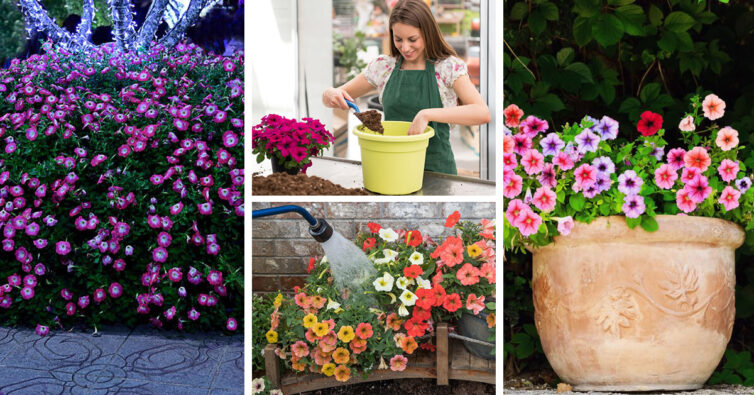These vibrant-colored plants are everywhere, but particularly in gardens and landscapes. Many Petunias are perennials returning to green come warm weather. Others are annuals. You can use them as a pop of color wherever you want. Better still, petunia care is easy since they are low-maintenance. Water, fertilizer, and dead-heading are the trinity for keeping them healthy. Easy right?
Key Takeaways
- Petunias are low-maintenance plants, ideal for beginners or busy households.
- If you’d like a colorful ground cover, consider petunias in your landscaping plan.
- Bees, hummingbirds, and butterflies find the sweet aroma of petunias alluring.
Peaceful Petunias
If you’re sitting outside on a nice day, you’ll notice hummingbirds visiting them. Because they’re tubular, petunias have a direct source of nectar. It’s really delightful to see them fly so fast.
Do you want a colorful ground cover? Consider trailing varieties like Easy Wave (yellow), Trilogy (purple), Flash Forward (Perry Winkle), Skybox Rose (pink and white), and Success White (all white). Since these flowers spread quickly, they actually deter weed growth.
You can put them in as outdoor hanging baskets and pots or right into the ground. Petunias are simply charming. They add a touch of pizazz.
A Black Sheep in the Family: Petunias belong to the Solanaceae family. This means they’re kissin’ cousins to the deadly nightshade. Thankfully. there are far more relatable plants in the Petunias family line, including peppers, tomatoes, and potatoes (anyone for soup?)
Principle Outdoor Petunia Care
There are a few things you can do to make your Peunias happy. Make sure their soil is always moist. During hot spells, you may need to water them daily. Just don’t get overzealous. Over-watering Petunias makes them scraggly and decreases flowers.
No matter how much you love your country-style watering pan, put water on the Petunia’s soil. Avoid getting water on flowers and leaves. The dampness can impel diseases, especially if your plants are close together.
Petunias are a hungry lot. They will need regular fertilizing. Check your local greenhouse for suggestions, Especially in liquid form.
Finally, let the sun shine! Petunias require 6 hours of full sun daily.
Petunias Can Self-Pollinate: These flowers are unique in that they can self-pollinate. They produce seeds and offspring without any of the normal pollinators, like bees.
Necessities for Healthy Outdoor Petuniasl
Dig It: Sun and Soil
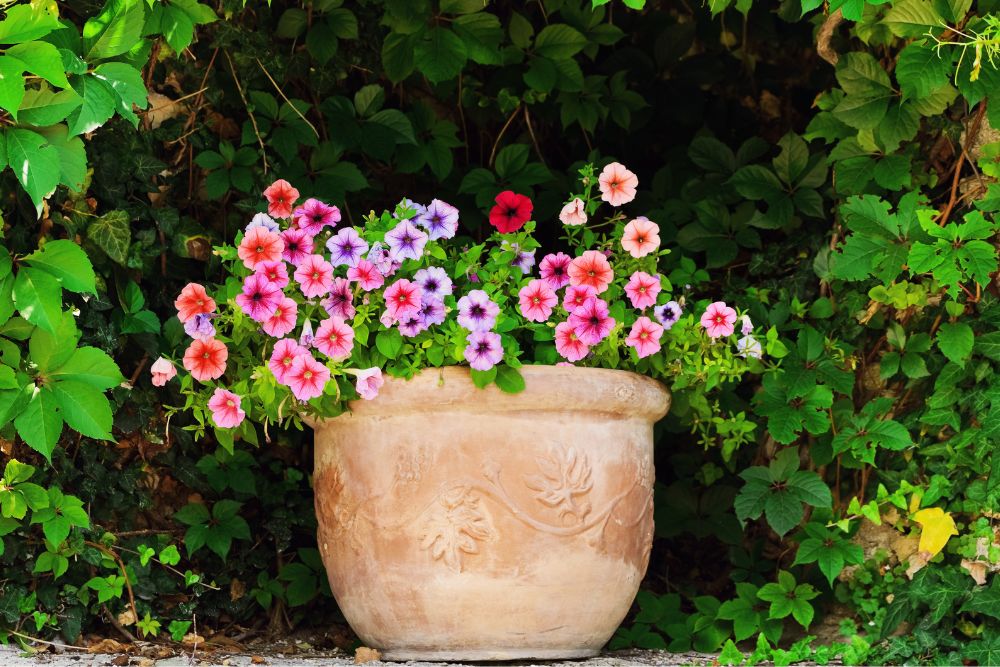
Petunias can withstand full sun, Shade decreases flower production. If you can’t offer full sun, look to a place the plant where there’s a mix of sun and shade.
The most important thing about your soil is proper drainage. Whether your plant is in-ground, hanging, or potted, petunias thrive in areas with good drainage, including when planted in a pot or hanging basket.
You can add 2 inches of organic matter and mix it into your soil well. A little sand in the mix serves as a drainage helper. Along with the soil, fertilization is a question. Balanced fertilizers work best (8-8-8). They’ll need feeding in early July, followed by more fertilizer every three weeks. Note that potted or window boxed Petunias will need weekly fertilizing. Come July, fertilize every two weeks. If you have spreading petunias, they need weekly feeding.
It doesn’t hurt to contact a soil testing lab, often available in college extension. The results will tell you exactly what changes you need to make before putting your petunia in the dirt.
Petunias are heat tolerant. If you live in a hot, humid area, Petunias are an ideal choice for your landscape. They love the sun. Just take care that their soil remains moist.
Gardening with Petunias
There are over 35 species of Petunias. Each has what you might call a floral fingerprint. Whatever plant you choose will have specific requirements for water, soil, and light. This diversity is fantastic for gardeners who want hardy plants for their local.
Floribundas: These flowers rest between grandiflora and multiflora. They flower like the multiflora blossoms but have smaller petunias. Floribundas are intermediate between the grandiflora and the multiflora groups.
Grandifloras: Not a good choice if you live in a hot region. Grandiflora has heavy blossoms, with significant flowers measuring 3- 4 inches, some of which are double. When mature, Grandiflora measures 12-14 inches. They are fantastic choices for hanging.
Millifloras: Millifloras if you like petite flowers, Milliforas Petunias are worth your consideration. They measure, at most, 1 1/2 inches. You won’t need to prune them, and they blossom for what feels like forever. These are low-growing but spread as much as 3 to 4 feet. They form a beautiful, colorful ground cover because the flowers form along the entire length of each stem. They can be used in window boxes or hanging baskets.
Multifloras: Durable plants that blossom with glee. They’re smaller than grandiflora but make up for it with vigor. You can expect flowers from summer until the first frost. They have a resistance to petal blight, and they’re both single and double-petaled versions.
Purple Wave: Purple Wave has the honor of being the first cultivar created in the spreading petunia category. The flowers are stunning purple-maroon. The Purple Wave has a reach of up to 4 feet and is 4 inches tall.
Spreading or Trailing Petunias: Spreading petunias reach up to 4 feet at maturity. Flowers blossom along both sides of the stem as they create a carpet of color in your landscape. These look great in window boxes, too.
Petunias are not just a visual feast for your eyes. They have a delicate fruity-nutty scent, especially at dusk, surrounding you with aromatherapy. The scent of Petunia fosters positive relationships in the home, where you build bridges and foster possibilities.
Tips about Watering Outdoor Petunias
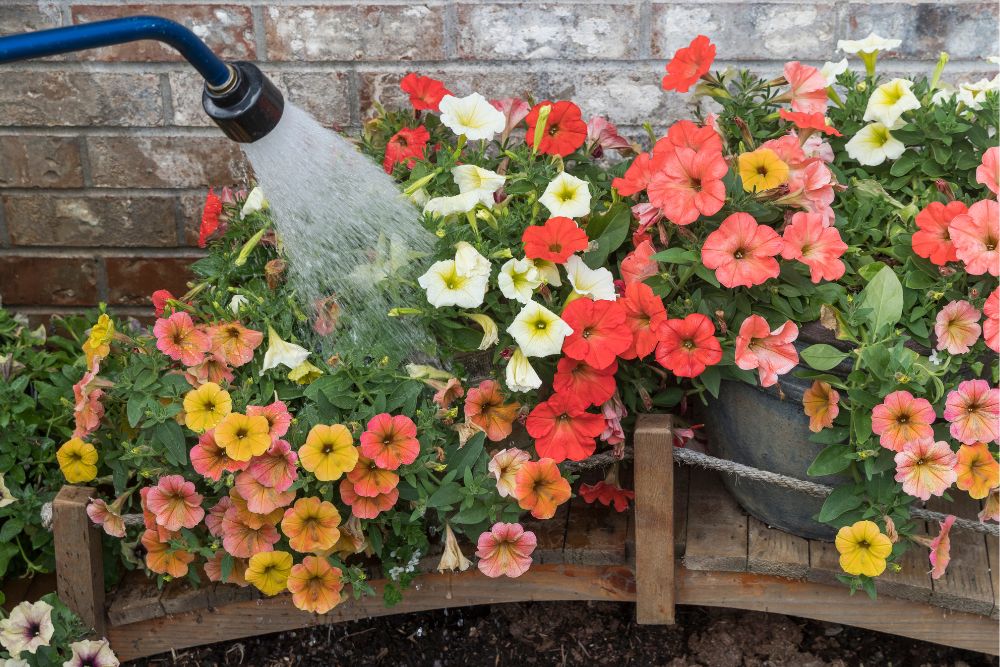
Petunias have shallow root systems and enjoy moist soil conditions. Their roots can dry out very quickly. Therefore, regular watering is paramount to the success of the plant. Make sure that the soil around the plant drains because petunia root systems cannot handle wet feet. Too much moisture can lead to root rot and the plant’s demise. Petunias that are planted in containers or hanging planters may require daily watering.
Water your petunias early in the day.
Set the Table: As long as you gather petunias without pesticides, those blooms are edible! Put petals in salad, cocktails, cake, and dessert. It’s gently sweet and minty. Petunias pair well with berries, golden raisins, feta, and poppy seeds.
Warning: Not all Petunias are edible. Petunia violacea and Sweet petunia are consumable. Always check for safety before you munch.
Potting & Repotting Outdoor Petunias
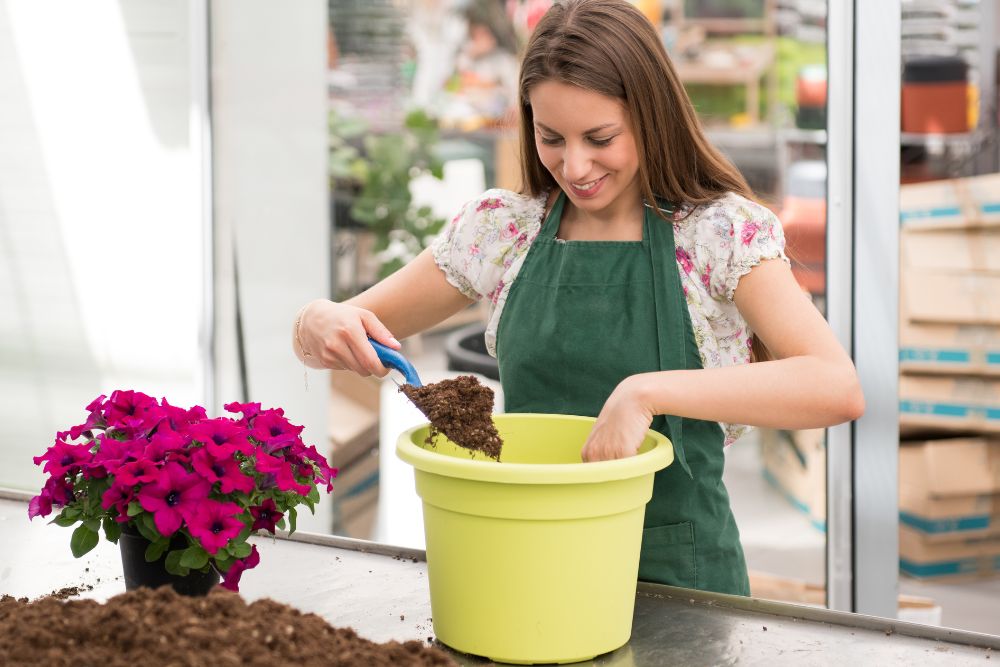
Whether you put your petunias in the ground or a pot, only put them into the garden after the threat of frost passes. Three petunias are the maximum for a 12” container. In sharing space, the petunias should all be at the same depth. This is true when you repot, too.
Amend your soil with organic matter, then gently fill around the plants until you reach about 1 inch from the top of the container. You can put mulch on the top to deter weeds from getting into the plant pot.
Prepare and put your potted petunia in late May to early June.
Most gardeners know the petunia by the name Petunia X hybrid. It is native to South Africa. The first printed mention of petunias occurred in 1803 by Antoine Laurent de Jussieu, a French Botanist. His name came from the word “petun,” which unflatteringly means “worthless tobacco plant.” Even so, breeders were fast to hybridize the species. In 1888 Burpee Seed Co released the first dark purple form. In the early 1900s, a seed company in Japan released the first double-petaled flower. Not so worthless, after all.
Pruning and Maintenance for Outdoor Petunia
Sometimes petunias need a haircut to keep them from getting leggy. Never cut back more than ⅓ of the plant. You’ll be rewarded for your efforts with new growth and blossoms. For about a week after pruning, you may find your plant has a case of limpness. They need to recover. Just keep your eyes on the soil and light. To avoid shock, take off a little weekly.
If you wish, you can deadhead your plants, but it’s unnecessary. They don’t seem to notice old flowers. When you do deadhead, ensure you get the whole flower, including the seed pod.If you prune your petunia three times in summer with care, it encourages more growth. After pruning, fertilize your plants.
Crystal Clear: The ancient belief in stones having powers has returned to the discussion board. For your Petunia, these are the suggestions:
- Amber: restored health
- Citrine: growth
- Moss Agate: rejuvenating potted plants
- Selenite: protection against pests and diseases
- Tiger’s Eye: improved rooting
Bury them for the best results. However, you could several stones and put it on top of the soil for a decorative effect.
Blooming and Resting Periods
If you live in a four-season region, you can bring your plant indoors where it remains from cold and frost. What do you do with the petunia once it’s inside? Treat it like a houseplant. Find a sunny spot, clear from cold breezes.
Alternatively, you could move the plant into dormancy. When the temperatures consistently drop below 40F, go outside and cut your petunias back. Reduce the stems by ⅓.
If the Petunias are in the ground, dig it up. Carefully wash away the soil around the roots. Review them for any signs of pests or disease. You don’t want such issues coming indoors.
Put them in a container with fresh soil. In the first week, water the Petunias normally. In the second week, let the top half inch of the plant dry, followed the next week by 1” dry. Be prepared for leaf loss. It’s normal. The plant is wholly focused on directing energy to the roots.
When the leaves finish falling, move the pot to a dark location like your basement (really anywhere hovering around 45F). Leave it be. Six weeks before the season begins, reverse the process. Gradually increase sunlight over a few weeks.
If the threat of frost is over and the plant has some new foliage, it’s ready to go back outside.
A beer company discovered the first Wave Purple Classic Petunia in 1995. A Japanese breeder for a beer company found a wild petunia growing happily in the field. The Pan American Seed Association partnered with the discoverer. Wave Purple was about to have a grand adventure: traveling worldwide!
Common Pests & Plant Diseases
Petunia plants are susceptible to various diseases and pests.
- Botryis Blight: Your flowers look like antique paper covered with gray fuzz. Spots may also appear on foliage. This blight thrives on humid, wet weather. To avoid this, clear your plants of dead leaves and spent flowers. Your petunias need air circulation. A Fungicide spray repeatedly applied can snuff the blight in the bud.
- Mosaic: Petunia can succumb to diseases on potatoes and tomatoes. Your leaves appear mottled and with crinkles. An alternative results in cupped, dwarfed leaves. Remove any plants with symptoms from your garden. Mosaic is hard to recover from.
- Spot Virus: Spots appear on your leaves looking like black rings. You can thank thrips for the infection. Like Mosaic, get sick plans out of your garden. Check your plants for thrip infections.
- Insects: Potato flea Beetle. This critter feeds on a variety of plants. You might notice round holes from the underside, The injury causes leaf death. These bugs come out in July. Since they hibernate until spring, treat your plant beforehand.
- Yellow Woolybear Caterpillar: These guys appear in late summer. You can see it as it grows to 2 inches. The Caterpillars create a hideout of their coats and silk, lying in place until spring. When they hatch, they emerge as a 2-inch moth. When you see them, handpick them off.
- Mites like petunia juice. It causes foliate to curl or cup and discolored flowers. You can find spider mites by their distinctive webs. Neem oil protects your plant pretty well from Mites. Continue treatment weekly until they’re clear.
Petunia Symbolism and Meaning: Modern florists ascribe the petunia as a symbol of hope, luck, comfort, and also desire. The Mayan and Incas said petunia warded off evil spirits. There’s more! Some colors of petunia have additional meanings. Pink petunia embodies femininity, motherly love, compassion, and a gentle nature. Red petunias are emblems of deep love and strong relationships.
White Petunias epitomize purity, spirituality, dignity, and trust, which makes them common flowers at weddings. Yellow characterizes friendship. Purple petunias exhibit grace and leadership, and blue petunias bear the message of peace, stability, and reliability.
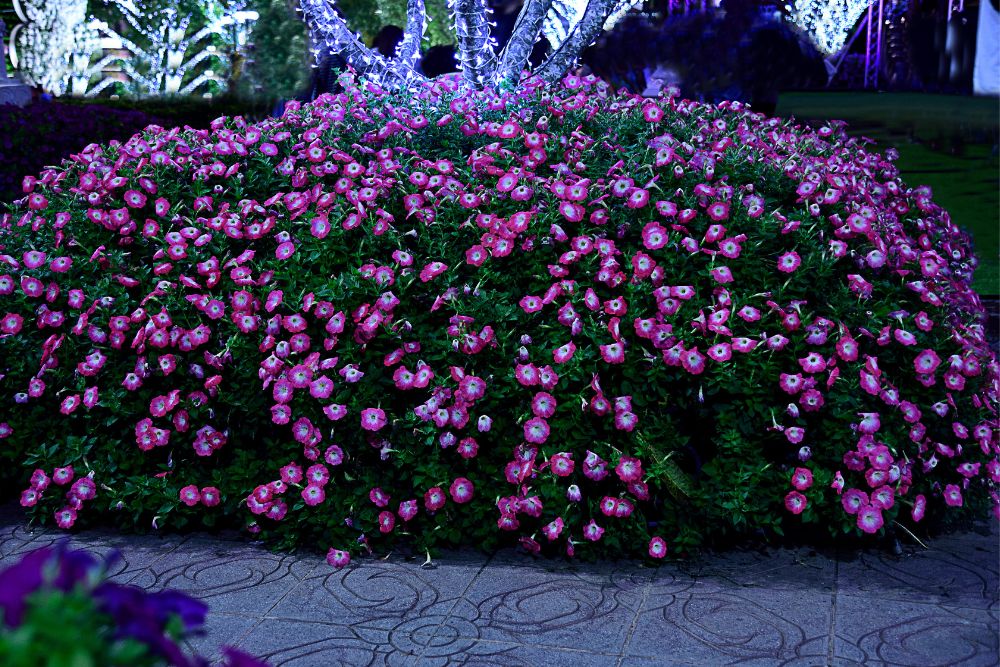
Troubleshooting Common Problems
- Why are my petunia leaves turning brown and dying? The most common reason for this is the lack of enough water.
- Lacking Blossoms: First, check how much light your plant is getting. Dimness reduces flower production. Your soil quality might be a problem, too. Fertilizers.
- Leggy Plants: Petunias may get lanky. It may be the result of too little light. Alternatively, your plants need more water.
In Your Dreams: Dream experts say seeing a pink petunia in your dream portends affection and happy occasions. A bundle of petunias is hopeful and promotes a positive outlook. If you see yourself in a garden of petunias, you’ll have renewed tranquility. A bed of petunias suggests healing.
[wp-faq-schema title=”Frequently Asked Questions About Outdoor Petunia” accordion=1]Summary
When folks think of petunias, various words come to mind. They’re charming, bright, mesmerizing, and fetching. In the world of flowers, these rank among the easiest to grow. Give your petunias enough light, water, and drainage, and you have little worry of failing.

